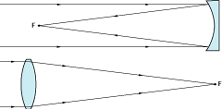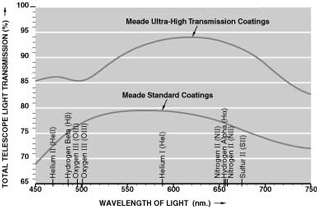| An
important optional feature to optimize the performance
of your Meade telescope.
Image brightness in a telescope is crucially
dependent on the reflectivity of the telescope's mirrors
and on the transmission of its lenses. Neither of these
processes, mirror-reflectivity or lens-transmission, is,
however, perfect; light loss occurs in each instance
where light is reflected or transmitted. Uncoated glass,
for example, reflects about 4% of the light impacting
it; in the case of an uncoated lens 4% of the light is
lost at entrance to and at exit from the lens, for a
total light loss of about 8%.
Early reflecting telescopes of the 1700's and 1800's
suffered greatly from mirrors of poor reflectivity—
reflection losses of 50% or more were not uncommon.
Later, silvered mirrors improved reflectivity, but at
high cost and with poor durability. Modern optical
coatings have succeeded in reducing mirror-reflection
and lens-transmission losses to acceptable levels at
reasonable cost. 
| Each
time light encounters a mirror (above) or
lens (below) surface, some light is lost. In the
case of a lens, light is lost both at entrance
to and at exit from the lens. |
Meade Standard Coatings: The optical surfaces
of all Meade telescopes include high-grade optical
coatings fully consistent in quality with the precision
of the optical surfaces themselves. These
standard-equipment coatings include mirror surfaces of
highly purified aluminum, vacuum-deposited at high
temperature and overcoated with silicon monoxide (SiO),
and correcting lenses coated on both sides for high
light transmission with magnesium fluoride (MgF2). Meade
standard mirror and lens coatings equal or exceed the
reflectivity and transmission, respectively, of
virtually any optical coatings currently offered in the
commercial telescope industry.

| Control
Panel of a Meade UHTC electron-beam vacuum
coater. |
The Meade UHTC Group: Technologies recently
developed at the Meade Irvine coatings facility,
however, including installation of some of the largest
and most advanced vacuum coating instrumentation
currently available, have permitted the
vacuum-deposition of a series of exotic optical coatings
precisely tuned to optimize the visual, photographic,
and CCD imaging performance of Meade telescopes. These
specialized, and extremely advantageous, coatings are
offered here as the Meade Ultra-High Transmission
Coatings (UHTC) group, a coatings group available
optionally on many Meade telescope models.
In Meade catadioptric, or mirror-lens, telescopes
(including the ETX-90EC,
ETX-105EC, and ETX-125EC; LX10,
LX90,
and
LX200GPS Schmidt-Cassegrains; and LXD55-Series
Schmidt-Newtonians) before incoming light is brought
to a focus, it passes through, or is reflected by, four
optical surfaces: the front surface of the correcting
lens, the rear surface of the correcting lens, the
primary mirror, and the secondary mirror. Each of these
four surfaces results in some loss of light, with the
level of loss being dependent on the chemistry of each
surface's optical coatings and on the wavelength of
light. (Standard aluminum mirror coatings, for example,
typically have their highest reflectivity in the yellow
region of the visual spectrum, at a wavelength of about
580nm.)
Mirror Coatings: Meade ETX, Schmidt-Cassegrain,
and Schmidt-Newtonian telescopes equipped with the
Ultra-High Transmission Coatings group include primary
and secondary mirrors coated with aluminum enhanced with
a complex stack of multi-layer coatings of titanium
dioxide (TiO2) and silicon dioxide (SiO2). The thickness
of each coating layer precisely controlled to within
+/-1% of optimal thickness. The result is a dramatic
increase in mirror reflectivity across the entire
visible spectrum; at the important hydrogen-alpha
wavelength of 656nm. — the predominant wavelength of
emission nebulae — reflectivity is increased from 89%
to over 97%.
|

| A
special UHTC label is affixed to the optical
tube of the each Meade telescope equipped with
these advanced coatings. |

| Total
telescope light transmission by wavelength of
light. These graphs show the total amount of
light transmitted to the telescope focus by the
four optical surfaces (primary mirror, secondary
mirror, and two lens surfaces) of Meade ETX,
Schmidt-Cassegrain, and Schmidt-Newtonian
telescopes. The wavelengths of the brightest
nebular emission lines are indicated in red.
Meade standard coatings equal or exceed the
total light transmission of virtually all other
optical coatings currently offered in the
commercial telescope industry; notwithstanding
this fact, Meade UHTC coatings enable a dramatic
increase in lunar, planetary, and deep-space
image brightness. Note that the graphs presented
here are spectrophotometric results of actual
Meade mirrors and correcting lenses, not
theoretical abstractions. |
Correcting Lens Coatings: Meade telescopes
ordered with the UHTC group include, in addition, an
exotic and tightly-controlled series of coatings on both
sides of the correcting lens or correcting plate,
coatings which include multiple layers of aluminum oxide
(Al2O3), titanium dioxide (TiO2), and magnesium fluoride
(MgF2). Per-surface light transmission of the correcting
lens is thereby increased at the yellow wavelength of
580nm., for example, to 99.8%, versus a per-surface
transmission of 98.7% for the standard coating.
The importance of the UHTC group becomes
apparent when comparing total telescope light
transmission, or throughput, caused by the multiplier,
or compounding, effect of the four optical surfaces.
With each optical surface contributing significantly to
telescope light throughput, the effect of all four
surfaces combined is indeed dramatic, as demonstrated by
the graphs on the facing page, as well as by the table
of the brightest nebular emission lines. At the H-alpha
wavelength of 656nm., total transmission increases from
77% to 93%, an increase of 93/77 or 21% at all three
nitrogen-III and sulfur-II wavelengths of 655nm. and
673nm.— prominent lines in certain galactic nuclei and
in supernova remnanats such as the Crab Nebula—
transmission increases by 21%; ; at the helium
wavelengths of 588nm. and 469nm. — strong emission
lines in hot planetary nebulae — total telescope
transmission increases by 18% and 19%, respectively; at
the two nitrogen II lines of 655nm. and 658nm. and at
the sulfur II line of 673nm., transmission is increased
by 21%. Averaged over the entire visible spectrum
(450nm. to 700nm.), total light transmission to the
telescope focus increases by about 20%.
Observing with the UHTC: Meade ETX, Schmidt-Cassegrain,
and Schmidt-Newtonian telescopes equipped with the UHTC
present dramatically enhanced detail on the full range
of celestial objects — from emission and planetary
nebulae such as M8,
Emission
Line |
Wave-
length
(nm.) |
Transmission:
Standard
Coatings (%) |
Transmission:
UHTC
Group (%) |
Increase* |
Hydrogen-
alpha (Ha) |
656 |
76.9 |
93.1 |
21% |
Hydrogen
beta (Hß) |
486 |
75.3 |
85.8 |
14% |
| Oxygen
III |
496 |
76.5 |
85.4 |
12% |
| Oxygen
III |
501 |
77 |
85.4 |
11% |
| Helium
II |
496 |
72.5 |
86.1 |
19% |
| Helium
I |
588 |
79.5 |
93.5 |
18% |
| Nitrogen
II |
655 |
77 |
93.2 |
21% |
| Nitrogen
II |
658 |
76.7 |
92.8 |
21% |
| Sulfer
II |
673 |
75.7 |
91.8 |
21% |
* The %
increase is obtained by dividing the UHTC-transmission
(column 4) by the standard coatings transmission (column
3).
M20, and M57 to star clusters and galaxies such as
M3, M13, and M101. Observations of the Moon and planets,
since they are observed in reflected (white) sunlight,
benefit in image brightness from the full spectrum of
increased transmission. The overall effect of the UHTC
is, as it relates to image brightness, to increase the
telescope's effective aperture. Image brightness
(i.e., the ability to see faint detail) of the Meade
10" LX200GPS is, for example, effectively increased
by about one full inch of aperture.
Effects on CCD Imaging: While the human eye
loses sensitivity to light beyond wavelengths of about
700nm., CCD imaging chips remain sensitive to about
750nm. and longer, wavelengths at which the reflectivity
of an aluminum coating is near its lowpoint.
Importantly, however, the UHTC's total light
transmission at 750nm. is 83%, vs. 72% for standard
coatings, an increase of 83/72, or 15%.
Ordering the UHTC: The Meade Ultra-High
Transmission Coatings group, if desired, must be
specified at the time of telescope purchase; the UHTC
can not be retrofitted. The UHTC is available for
any of these Meade telescopes:
ETX telescopes: ETX-90EC,ETX-105EC,ETX-125EC
Schmidt-Cassegrains: 8"
LX10,8"
LX90, 7"
LX200GPS, 8"
LX200GPS, 10" LX200GPS,12"
LX200GPS, 16"
LX200GPS
LXD55 Schmidt-Newtonians: 6"
Model SN-6, 8" Model SN-8,10" Model SN-10 |